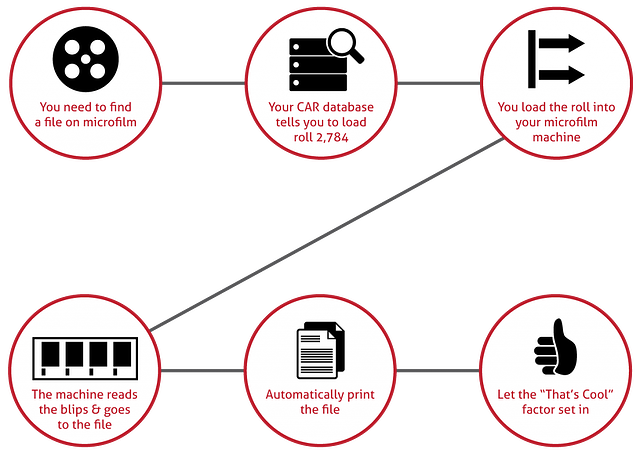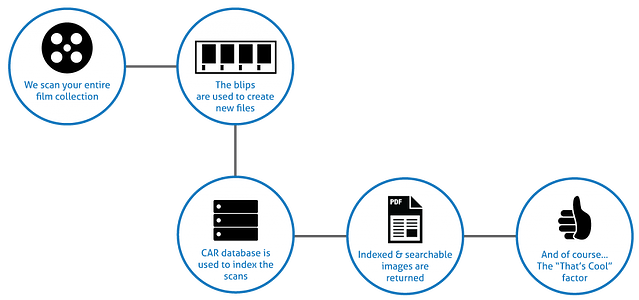There's no need to check your calendars. Yes I'm writing about microfilm CAR systems and no it's not 1995.
Microfilm CAR (Computer Assisted Retrieval) systems were developed in the 80’s as a way to quickly locate any image across a vast microfilm collection. It was really an ingenious system at the time; a computer database would contain a detailed inventory of all your microfilm rolls. So if you were looking for Kevin D'Arcy’s student record, you could search on ‘Kevin D'Arcy’, filter down the results using additional fields such as data of birth, and the system would tell you his file was located on roll 2,784 at frame 346. You would simply pull roll 2,784 from the cabinet, load it into your microfilm reader printer and it would automatically advance the roll to frame 346, bringing you right to Kevin’s file. You could even configure it to automatically print the record. For the visual people in the group:
Now for those of us who are used to electronic imaging systems, this seems normal, familiar even. But you have to imagine that this was being done in the 80’s. Systems like these could locate and print one file out of millions in a matter of minutes; now how cool is that?
As revolutionary as this technology was, its day has come and gone. While many organizations still have/use microfilm, its role has changed drastically over the years from a primary retrieval media to an “insurance policy”, if you will , used strictly as a back-up and disaster recovery media. However, these CAR systems were so predominant in their day that many companies are still clinging to these old systems. With the majority of the new microfilm scanners not being able to read the frame blips, the future of these systems are looking pretty grim.
Fear not! There are alternatives and they provide improved functionality and access to your vital microfilm records.
You see, microfilm that is part of a CAR system is the easiest and most cost effective microfilm to digitize. Those blip marks under the images that indicate the frame number allow modern day production microfilm scanners to automatically recognize the start and stop position of each new file on the roll of film and batch the scanned images accordingly. And that database of roll information you have? That content can be matched up to scanned files to automatically index your files. Right away you have eliminated the two most expensive barriers to microfilm scanning: file separation and indexing. Again, for our visual readers:
Microfilm reader printers with the ability to identify blips and integrate with CAR systems are becoming rare As such, the pricing is going up and after 5-7 years of expensive repairs and supplies you’ll have to invest in that technology all over again. Not to mention the scenario you could be in if your machine goes down and there were no replacements available; what would the impact of not being able to retrieve this information be on your business?
So stop the endless cycle of machine replacements and scan your microfilm collection today. Remember your CAR microfilm system is one of the most affordable and accurate microfilm collections to digitize.


